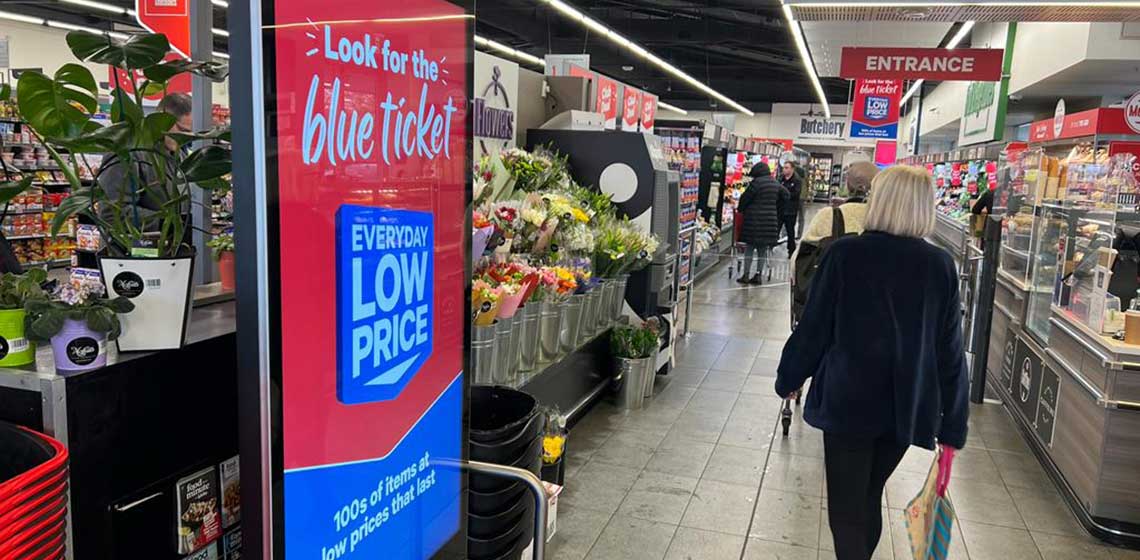Unlocking new opportunities with Digital Screens
Grocery stores are busy places, with some of the largest chains welcoming tens, if not hundreds of millions of visitors every week. By virtue of that fact, store media – across many different formats that range from radio to point-of-sale – has the ability to engage a wider audience than even some of the largest broadcast media outlets and print publications.
For brand advertisers entrusted with showcasing their products to both new and loyal customers, this presents a golden opportunity. Not only does store media provide them with access to a potentially massive audience, it gives them access to those people at a time when they’re already looking for inspiration and ideas about what to buy next.
Opportunity, of course, doesn’t always translate into guaranteed success. Grocery stores really are busy places, presenting shoppers with numerous distractions at once. Combined with the fact that grocery shopping can also be a fairly utilitarian exercise – with many customers wanting to get in, grab what they came for, and get out again – achieving the requisite cut-through to provoke a response is crucial.
Enter digital screens. In one survey conducted mid-last year, 11,000 people from around the world had more than a few positive things to say about digital signage[1]. 50% of consumers said that digital screens encouraged them to make a purchase “right there and then”, 53% that they gave them all of the information they needed to make a purchase, and 77% that they found them to be either “very” or “quite” informative.
Shoppers aren’t the only ones enticed by the appeal of digital screens, either. While it dates back a little now, one grocery-focused study looking at the impact of digital signage for suppliers found that four out of five saw sales uplift of up to 33%[2]. As good as digital screens are at raising awareness and prompting consideration, they clearly drive impact at the lower end of the marketing funnel too.
To me, it’s this rich diversity that defines the true appeal of digital screens. Retail media, and specifically grocery-based media, is set up in a way that enables suppliers to meet multiple objectives via the same channels at once. Gone are the days when digital screens were solely the domain of shopper marketing teams; it's evident that, when utilised strategically, these assets can accomplish a spectrum of tasks, ranging from elevating brand awareness to inspiring impulse purchases.
At the heart of this shift is the growing amount of flexibility on offer. Digital screens at the entrance to stores may have been (relatively) commonplace for some time now, but signage within the in-store environment is becoming similarly pervasive too. In Foodstuffs stores across North Island, for instance, suppliers now have access to everything from storefront displays through to “goalpost” screens in-aisle.
Much as this presents suppliers with a greater range of formats with which to communicate with shoppers, it also speaks to the growing level of creative freedom on offer, too.
As noted above, digital screens aren’t “just” being used for traditional purposes like showcasing new products anymore. With some retailers now offering much greater flexibility when it comes to creative approaches, we’re seeing a much greater opportunity for brand expression, too. Above the line campaigns that shoppers may already have seen on television can now be extended into the store in new and engaging ways.
Digital Screens campaigns across the Foodies estate have delivered similarly impressive results over the past 12 months. Data gathered in the post-campaign period shows sales uplift of 25% for one leading rice brand, 24% for a drinks brand, and 16% for a crisp supplier. Context-sensitive content was again at the heart of these campaigns, ensuring maximum relevance for passing shoppers.
Relevance is its own consideration when it comes to digital screens, of course. One of the key advantages of digital signage over printed display is that screens allow for messages to be tailored and updated much faster and more cost effectively. With the right creative approach and – crucially – the right insights behind them, suppliers can use digital screens to “own the moment” when communicating with shoppers.
There are numerous ways in which this can play out. Perhaps it’s a calendar-based approach, with ads tailored to key dates like Valentine’s Day or a public holiday. It could be temperature controlled, with brands activating ads for specific products when the mercury soars (or plummets). It can even be a simple reminder that it’s almost the weekend, and thus a good time for shoppers to let their hair down a little.



So, digital screens offer reach, results, and relevance – but there’s one more thing that I’d like to add to that list, and that’s accountability.
Of the many benefits offered by grocery-based digital signage, I’d argue that one of the most powerful (particularly right now) is the ability for suppliers to track the direct impact of their efforts on key performance indicators like sales and category share. With the store environment providing a “closed loop” that links what people see with what they buy, advertisers can gain detailed insight into the effectiveness of their campaigns.
Importantly, that capability is only going to improve as we move forwards into the future. As time goes by, our ability to measure the performance of digital screens will get even better than it is today.
From shopper to brand marketing, awareness to action, digital screens provide a way to do it all – and prove the impact of doing it, too.
[1] The DOOH Difference Report – Sightline, 2022
[2] Nielsen study: DOOH increases revenue at the point of sale – Digital Signage Today, 27th January 2010
TOPICS
RELATED PRODUCTS
Make Retail Media work for your business with Customer Data Science
Retail Media solutionsThe latest insights from our experts around the world
AI and data science in 2026: the trends everyone’s talking about



